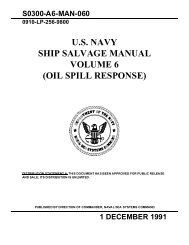FACEPLATE FNL (April 2004) - Supervisor of Salvage and Diving
FACEPLATE FNL (April 2004) - Supervisor of Salvage and Diving
FACEPLATE FNL (April 2004) - Supervisor of Salvage and Diving
You also want an ePaper? Increase the reach of your titles
YUMPU automatically turns print PDFs into web optimized ePapers that Google loves.
VICE ADMIRAL CHARLES “SWEDE” MOMSEN<br />
U.S. Navy <strong>Diving</strong> <strong>and</strong> Submarine Pioneer<br />
Vice Admiral Charles B. Momsen, USN (1896 -<br />
1967).<br />
Vice Admiral Charles Momsen was a<br />
major contributor to diving research,<br />
submarine rescue, diving equipment<br />
development, deep diving operations, <strong>and</strong><br />
operations with military submarines.<br />
During his long <strong>and</strong> distinguished career<br />
in the U.S. Navy, he contributed many<br />
diving innovations, developed some very<br />
advanced diving techniques, <strong>and</strong> was<br />
instrumental in numerous progressive, lifesaving<br />
operations.<br />
Charles Bowers Momsen was born<br />
on June 21, 1896 in Flushing, Long Isl<strong>and</strong>,<br />
New York. He attended public schools in<br />
Washington, D.C. <strong>and</strong> St. Paul, Minnesota<br />
before his appointment in 1916 to the U.S.<br />
Naval Academy. He graduated from<br />
Annapolis with the Class <strong>of</strong> 1920, was<br />
commissioned an Ensign on June 7, 1920,<br />
<strong>and</strong> served aboard the battleships USS<br />
OKLAHOMA <strong>and</strong> USS MARYLAND<br />
before reporting for submarine training at<br />
the Navy Submarine Base, New London,<br />
Connecticut in 1921. He served as<br />
Executive Officer <strong>of</strong> the submarine USS<br />
O-13 <strong>and</strong> comm<strong>and</strong>ed the submarines USS<br />
O-1 <strong>and</strong> USS R-24.<br />
He was then transferred to the Bureau<br />
<strong>of</strong> Construction <strong>and</strong> Repair where he<br />
helped develop the famous submarine<br />
escape device known as the Momsen Lung.<br />
After the submarine USS S-4 sank<br />
<strong>of</strong>f the coast <strong>of</strong> Provincetown in<br />
December <strong>of</strong> 1927 with the loss <strong>of</strong> forty<br />
lives, the U.S. Congress appropriated<br />
money for the Navy to develop effective<br />
submarine safety <strong>and</strong> rescue systems.<br />
Just a few months before the USS S-4 sank,<br />
LT Momsen had been in comm<strong>and</strong> <strong>of</strong><br />
her sister ship, the USS S-1.<br />
Momsen <strong>and</strong> his team started<br />
from scratch in developing a submarine<br />
escape breathing system. Momsen was<br />
given a submarine to use as a floating<br />
laboratory - none other than the salvaged<br />
<strong>and</strong> reconditioned USS S-4, which<br />
served as a constant reminder <strong>of</strong> the<br />
importance <strong>of</strong> success by the research<br />
team. The result <strong>of</strong> their hard <strong>and</strong> dedicated<br />
work looked like a hot water bottle with<br />
a gas mask. It had a capacity equal to<br />
that <strong>of</strong> the human lungs. One tube carried<br />
air from the mouth to the bag. Another<br />
tube enclosed a container <strong>of</strong> soda lime<br />
to purify the air <strong>of</strong> carbon dioxide <strong>and</strong><br />
carried the air from the bag to the mouth.<br />
On February 5, 1929, the submarine<br />
USS S-4 was submerged in 40 feet <strong>of</strong><br />
water at Smith Shoals, 11 miles <strong>of</strong>f the<br />
coast <strong>of</strong> Key West, Florida. Lieutenant<br />
Momsen <strong>and</strong> Chief Torpedoman<br />
Edward Kalinowski were the first to<br />
successfully test the Momsen Lung. The<br />
test team continued to test the Momsen<br />
Lung, going deeper <strong>and</strong> making<br />
refinements. Finally, on March 7, 1929,<br />
Momsen <strong>and</strong> Kalinowski escaped from 204<br />
feet. For this development he was awarded<br />
the Distinguished Service Medal.<br />
LCDR Momsen became Officer-<br />
In-Charge <strong>of</strong> the U.S. Navy Experimental<br />
<strong>Diving</strong> Unit (NEDU) in Washington, D.C.<br />
in August <strong>of</strong> 1937. He became a qualified<br />
deep sea Diver himself. Two surgeons from<br />
the Navy Medical Corps were assigned to<br />
work with Momsen to find a substitute for<br />
nitrogen in the Diver’s breathing gas for<br />
deep diving. Under Momsen’s leadership,<br />
the NEDU Team perfected new heliumoxygen<br />
mixtures <strong>and</strong> new decompression<br />
tables to allow Divers to safely work at<br />
depths over 300 feet.<br />
On May 23, 1939, the submarine<br />
USS SQUALUS sank <strong>of</strong>f the coast <strong>of</strong><br />
Portsmouth, New Hampshire during sea<br />
trials. The submarine was str<strong>and</strong>ed on the<br />
bottom 243 feet down. Since the submarine<br />
was below the safe limit to use the Momsen<br />
Lung, the SQUALUS captain decided to<br />
wait for possible rescue.<br />
Momsen <strong>and</strong> the NEDU Divers, their<br />
new mixed-gas diving equipment, <strong>and</strong> the<br />
McCann Rescue Chamber were quickly<br />
loaded aboard the salvage ship USS<br />
FALCON. Some years earlier, Momsen had<br />
worked with CDR Allan McCann in<br />
development <strong>of</strong> the McCann Rescue<br />
Chamber. LCDR Momsen directed the<br />
NEDU Divers in descending to the stricken<br />
submarine, making contact with the<br />
crewmen inside, attaching the rescue<br />
chamber haul-down line <strong>and</strong> assisting in<br />
the rescue. The McCann Chamber<br />
successfully rescued 33 <strong>of</strong> the 50 crewmen<br />
aboard the submarine USS SQUALUS.<br />
Following Momsen’s direction, the NEDU<br />
Divers made 640 additional mixed-gas dives<br />
over the next few months to salvage the<br />
sunken SQUALUS, bringing the submarine<br />
to the surface under the most severe<br />
weather <strong>and</strong> water conditions. Four <strong>of</strong> the<br />
Divers on the rescue <strong>and</strong> salvage<br />
operations were awarded the Congressional<br />
Medal <strong>of</strong> Honor by President<br />
Roosevelt.<br />
Crewman A.L. Rosenkotter <strong>of</strong> USS V-5 (SC 1)<br />
demonstrates the use <strong>of</strong> the submarine's after<br />
escape hatch <strong>and</strong> the emergency escape "lung"<br />
during V-5's trials in July <strong>of</strong> 1930.<br />
A u g u s t 2 0 0 4 1 5

















